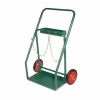Group Info
Safety Tips When Using Gas Cylinders Cart
Gas cylinders are a common tool in many industries. From welding to industrial equipment, gas cylinders are used every day, and they can be a great asset to any business or home. However, there are also some safety precautions that you should follow when using gas cylinders. It will help ensure that your employees, family members, and guests remain safe from any potential dangers associated with this equipment. Below is a list of some general safety tips for using gas cylinders:
Choose the right fuel for your gas cylinder
When using a gas cylinder, it's important to ensure you have the right fuel. It is done by checking the label on the cylinder. The label will tell you what type of fuel it holds and whether or not it has been used before. If you need clarification, contact the manufacturer of your gas cylinder cart or a professional to check it for you.
Be sure to remove any gas from the cylinder before storing it
Before storing your cylinder, be sure to remove any gas from it. It can be done using a gas can or other professional equipment. Do not use a hose to remove gas from the cylinder; this can cause serious injury if you inhale too much. Use only approved tools for removing air from your cylinder (such as providing a rounded end for easy access). Never use a funnel or mouthpiece to remove air from the container—they are unsafe and could lead to serious injury or death if mishandled.
Finally, never place hands inside a pressurized container while attempting to drain any remaining liquid into another container; instead, take care of how you extract any leftover fuel so as not to allow accidental contact with skin or eyes during this process.
If you have extra gas in the cylinder, stick them safely away from children and pets as an added safety precaution.
If you have extra gas in the cylinder, stick them safely away from children and pets as an added safety precaution.
Store your gas tank carts upright. Keep the cylinder away from heat sources.
If you have extra gas in your cylinder and want to store it for future use, follow these steps:
If any pressure is left in your tank, release it using a backflow valve (explained below). It will allow any remaining pressure to escape into the atmosphere and avoid an explosion while moving or storing it.
Turn off all valves on top of your tank except the fill valve—to ensure that no new liquid can enter inside it while transporting or storing.
Place caps over all other openings, such as filler pipes, outlets, and regulators, if they aren't already covered by default with this device.
Gas cylinders can topple over if they're knocked over. It is rarely dangerous, but it can cause injury.
Gas cylinders can topple over if they're knocked over. It is rarely dangerous, but it can cause injury.
Here are some tips to help you avoid this problem:
Store your gas cylinder upright, not on its side or upside down.
Keep everything heavy on top of your cylinder.
If you think your gas cylinder has been knocked over, follow these steps:
Gas cylinders should be stored upright and kept in a secure location away from children and animals.
It would help if you kept your gas cylinders upright and in a secure location away from children and animals. Gas cylinders must be stored out of reach of children and pets.
Gas cylinders are typically marked with a color code, including a code indicating the size of the cylinder.
Gas cylinders are typically marked with a color code, including a code indicating the size of the cylinder. Cylinders are marked with a color code that indicates their size. The code is typically red, yellow, or green and is often in a circle shape.
You must always check these codes before using your gas cylinder to ensure you have one appropriate for your project.
If your fuel has a different color than normal or is a different shape or size, use caution until you have verified that it is safe to use.
If your fuel has a different color than normal or is a different shape or size, use caution until you have verified that it is safe to use.
If you are not sure, do not use the fuel. Call the supplier and ask for advice on what to do. If you need help with what to do, contact your local fire department for assistance before using the cylinder.
Safety precautions when using gas cylinders
Here are the safety precautions when using gas cylinders:
Read the instructions in your owner's manual. If you do not have an owner's manual for your particular cylinder, contact the manufacturer or your local gas supplier for more details about using and storing it safely.
Store them in a safe place away from children and pets; never leave them lying around where they can be knocked over by accident! Also, ensure that there is nothing flammable lying around close by so that accidental fires don't start if a child or pet knocks over one of these cylinders while playing with them (this is why many people choose not to keep them inside).
Never use a gas cylinder that has been dropped or damaged in any way since this will make it more likely than usual for leaks to occur during use--and these could cause fires if care isn't taken when handling such casks after they've suffered damage during transport, etcetera."
Conclusion
These are just a few safety precautions that should be taken when using gas cylinders. It is important to remember that you can use these tips to keep yourself, your family, and your home safe from any potential dangers associated with this type of product.
